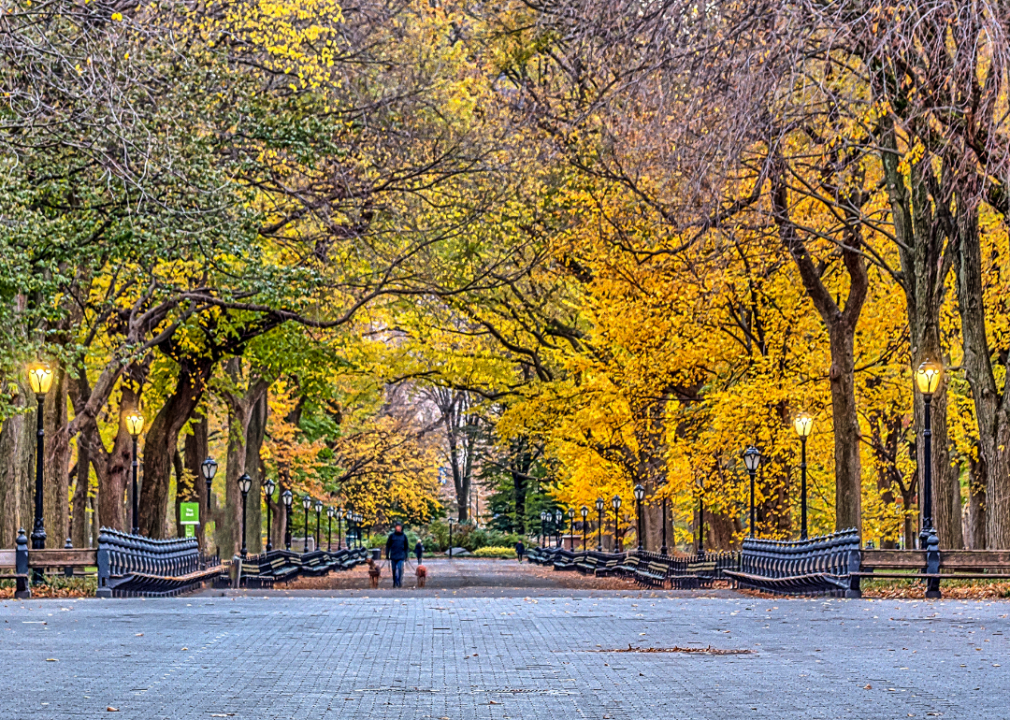
Ohio has 6 of the 50 cities with the most green space per capita
Ohio has 6 of the 50 cities with the most green space per capita
Green space is beneficial anywhere, but especially in concrete jungles like those found in many U.S. cities. The World Health Organization reports that green areas are essential to both the ecosystem and the mental health of citizens; though the color is fading quickly in urban areas that are cutting down trees and rapidly building on open space. There are, however, some cities across America that are fighting hard to keep green space within their borders.
Using data from the Organization for Economic Co-operation and Development, analyzed by the United Nations Office for the Coordination of Humanitarian Affairs, Stacker considered the 70 U.S. cities with the most green space per capita and then ranked the top 50 by the green space areas devoted to parks and urban regions.
Read on to see which cities in your state made the list, or see the national story here.
#47. Toledo
- Green space per capita: 2,724 sq. ft.
- Population: 607,456
Toledo encourages residents to "Get Outside Yourself" with the city's Metroparks system, which boasts 10,000 acres of green space along the western shores of Lake Erie. In the system sits the Toledo Botanical Garden, 50 acres of pristine land famous for the annual Crosby Festival of the Arts. Through continued land management in the Oak Openings Preserve, up to 2,766 acres of land and state-listed rare plants and animals remain sustained.
#35. Akron
- Green space per capita: 7,500 sq. ft.
- Population: 703,825
Since Akron hosted the 2018 Innerbelt National Forest event, which featured trails, almost 100 newly planted trees, and events for the community to gather and discuss the future, the city decided to make the decommissioned highway into a 35-acre park. When Akronites are not busy turning freeways into forests, they enjoy 14,000 acres of green space in the Summit Metro Park System, with Firestone Park in Akron featuring a sled hill drop-off, Little Turtle Pond, and Tuscarawas Meadows.
#33. Cleveland
- Green space per capita: 8,260 sq. ft.
- Population: 33,768
The city of Cleveland is doing it all it can to keep it green, reporting that green space is a "main driver in economic prosperity and a crucial factor in retaining and attracting residents to a city plagued with depopulation." The Cleveland Tree Plan, inaugurated in 2015, aims to increase forest neighborhoods that canopy the city from 19% to 30% by 2040. Other government programs include the Rain Barrel Program, a garden project to capture stormwater, and the Riparian Setback Ordinance, a law established to protect streams and wetlands.
#32. Dayton
- Green space per capita: 8,360 sq. ft.
- Population: 800,836
Designated as one of the top 10 U.S. cities with the most green space by National Geographic in 2018, Dayton's West Mill Cascades are considered some of the most gorgeous green space. There is also a preserved 15,400 acres in the Five Rivers MetroParks system. With land protection goals including linking forests and parks along river beds and creating buffers to preserve open space, Five Rivers MetroParks maintains more than a dozen parks, three conservation areas, and four regional trails of green space.
#11. Columbus
- Green space per capita: 34,298 sq. ft.
- Population: 2 million
The Scioto Mile connects the Scioto River with downtown Columbus through a 145-acre network of waterfront parks, bike paths, and pedestrian walkways. The Sustainable Columbus Advisory Committee was formed in early 2019 with the goal of having green space within a 10-minute walking distance of every resident of Ohio's largest city. From a 13-acre Rose Garden to a topiary re-creation of a famous painting, Columbus hosts green space for all tastes.
#3. Cincinnati
- Green space per capita: 67,723 sq. ft.
- Population: 2.1 million
Recognized annually as one of the country's greenest cities, Cincinnati touts more than 115,000 acres of protected green space. The Queen City is also highly rated for its recreation, thanks to its vast system of parks and open spaces. The Green Cincinnati Plan is charged with setting the foundation for moving Cincinnati toward 100% renewable energy.
Some cities have gotten creative in constructing green space within their boundaries. Houston, Nashville, and Des Moines, Iowa, are among the many cities putting large green spaces on public rooftops. Atlanta even has plans to cover some of its highways with parks.
The former commissioner of the New York City Department of Parks and Recreation Adrian Benepe promotes the 10-Minute Walk campaign, an initiative to have a park within a 10-minute walk in all U.S. cities by 2050. Now the senior vice president for the Trust for Public Land, Benepe points to how green space helps the ecosystem. "When I see a tree, I see the work of God because a tree is a remarkable machine," Benepe said. "It does extraordinary things in exchange for very little."
What's more, the health benefits of parks and green spaces in cities are numerous, according to The National Recreation and Park Association. Large parks promote active living, which can reduce the risk of diabetes and heart disease, while research shows even small parks can reduce stress and improve creativity and mental health.
To learn more about which cities made the top of the list, keep reading below.
Cities with the most green space per capita
#1. Minneapolis, MN: 105,843 sq. ft. per capita
#2. Kansas City, MO: 93,349 sq. ft. per capita
#3. Cincinnati, OH: 67,723 sq. ft. per capita
#4. Washington, DC: 63,138 sq. ft. per capita
#5. Nashville, TN: 57,699 sq. ft. per capita



